Tamilnadu State Board New Syllabus Samacheer Kalvi 11th Maths Guide Pdf Chapter 4 Combinatorics and Mathematical Induction Ex 4.4 Text Book Back Questions and Answers, Notes.
Tamilnadu Samacheer Kalvi 11th Maths Solutions Chapter 4 Combinatorics and Mathematical Induction Ex 4.4
Question 1.
By the principle of mathematical induction, prove that, for n ≥ 1
12 + 22 + 32 + ……….. + n3 = \(\left(\frac{\mathbf{n}(\mathbf{n}+\mathbf{1})}{2}\right)^{2}\)
Answer:
Let P(n) = 12 + 22 + 32 + ……….. + n3
p(n) = \(\left(\frac{\mathbf{n}(\mathbf{n}+\mathbf{1})}{2}\right)^{2}\)
![]()
Step 1:
Let us verify the statement for n = 1
p(1) = 13 = \(\left(\frac{1(1+1)}{2}\right)^{2}\)
![]()
P(1) = 1
∴ The given statement is true for n = 1
Step 2 :
Let us assume that the given statement is true for n = k
P(k) = 13 + 23 + 33 + …………… + k3
![]()
Step 3 :
Let us prove the statement is true for n = k + 1
P(k + 1 ) = 13 + 23 + 33 + …………… + k3 + (k + 1)3
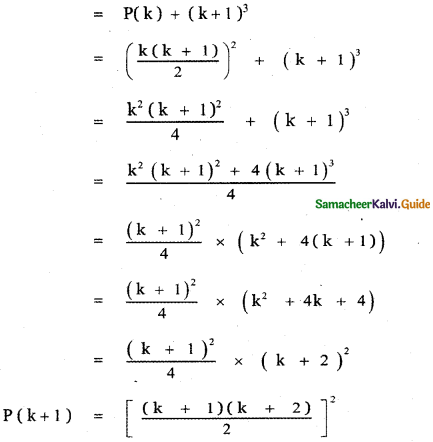
This implies P (k + 1) is true.
∴ Thus, we have proved the result for n = k + 1.
Hence by the principle of mathematical induction, the result is true for all natural numbers n.
12 + 22 + 32 + ……….. + n3 = \(\left(\frac{\mathbf{n}(\mathbf{n}+\mathbf{1})}{2}\right)^{2}\)
is true for all natural numbers n.
![]()
Question 2.
By the principle of mathematical induction, prove that, for n ≥ 1
![]()
Answer:

Step 1 :
Let us verify the statement for n = 1
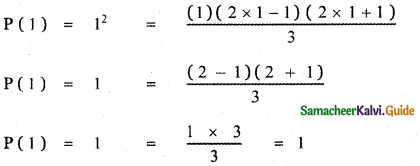
∴ The given statement is true for n = 1
Step 2 :
Let us assume that the given statement is true for n = k

Step 3:
Let us prove the statement is true for n = k + 1
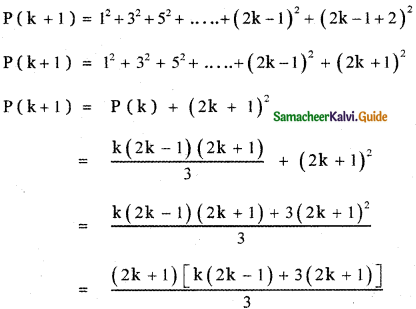
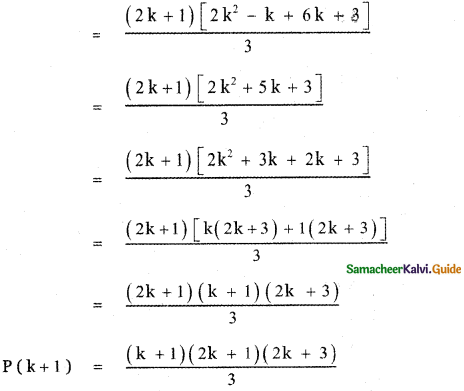
This implies P (k + 1) is true.
∴ Thus, we have proved the result for n = k + 1.
Hence by the principle of mathematical induction, the result is true for all natural numbers n.
![]()
is true for all natural numbers n.
![]()
Question 3.
Prove that the sum of the first ’n’ non-zero even numbers is n2 + n.
Answer:
Let P(n) : 2 + 4 + 6 +…+2n = n2 + n, ∀ n ∈ N
Step 1:
P( 1) : 2 = 12 + 1 = 2 which is true for P( 1)
Step 2:
P(k): 2 + 4 + 6+ …+ 2k = k2 + k. Let it be true.
Step 3:
P(k + 1) : 2 + 4 + 6 + … + 2k + (2k + 2)
= k2+ k + (2k + 2) = k2 + 3k + 2
= k2 + 2k + k + 1 + 1
= (k+ 1)2+ (k + 1)
Which is true for P(k + 1)
So, P(k + 1) is true whenever P(k) is true.
![]()
Question 4.
By the principle of mathematical induction, prove that, for n ≥ 1, 1 . 2 + 2 . 3 + 3 . 4 + …………. + n . (n + 1) = \(\frac{\mathbf{n}(\mathbf{n}+1)(\mathbf{n}+2)}{3}\)
Answer:
Let P(n) = 1 . 2 + 2 . 3 + 3 . 4 + ………… + n . (n + 1) = \(\frac{\mathbf{n}(\mathbf{n}+1)(\mathbf{n}+2)}{3}\)
Step 1:
Let us verify the statement for n = 1
P(1) = 1 . 2 = \(\frac{1(1+1)(1+2)}{3}\)
= 1 . 2 = \(\frac{1 \cdot 2 \cdot 3}{3}\)
∴ The result is true for n = 1
Step 2:
Let us assume that the result is true for n = k
P (k) = 1-2 + 2-3 + 3- 4 + + k (k + 1 ) =

Step 3:
Let us prove the result for n = k + 1
P(k + 1) = 1 . 2 + 2 . 3 + 3 . 4 + …………… + k (k + 1) (k + 1) (k + 1 + 1)
P (k + 1) = 1 . 2 + 2 . 3 + 3 . 4 + ………….. + k (k + 1) + (k + 1 ) (k + 2)
P (k + 1 ) = P(k) + (k + 1) (k + 2)
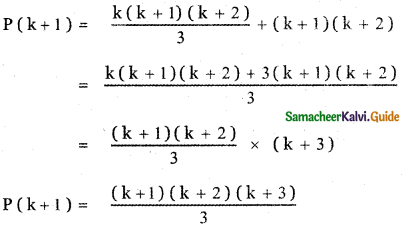
This implies P (k + 1) is true.
∴ Thus, we have proved the result for n = k + 1, Hence by the principle of mathematical induction, the result is true for all natural numbers n.
1 . 2 + 2 . 3 + 3 . 4 + ………. + n (n + 1) = \(\frac{\mathrm{n}(\mathrm{n}+1)(\mathrm{n}+2)}{3}\)
is true for all natural numbers n ≥ 1
![]()
Question 5.
Using the Mathematical induction, show that for any natural number n ≥ 2,

Answer:
Let

The first stage is n = 2
Step 1:
Let us verify the result for n = 2
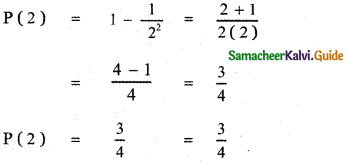
∴ The given result is true for n = 2.
Step 2:
Let us assume that the result is true for n = k.

Step 3:
Let us prove the result for n = k + 1
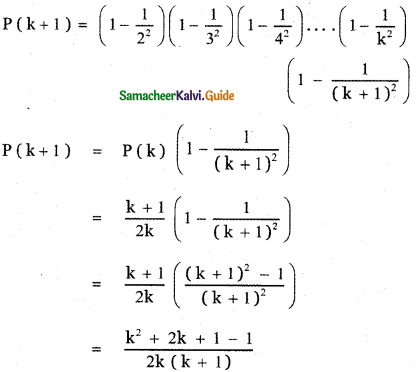
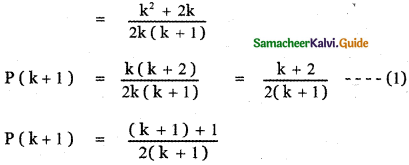
∴ Thus, we have proved the result for n = k + 1.
Hence by the principle of mathematical induction, the result is true for all natural numbers n ≥ 2.

is true for all natural numbers n ≥ 2.
![]()
Question 6.
Using the Mathematical induction, show that for any natural number n ≥ 2,

Answer:

Step 1:
Since n ≥ 2 the first stage is n = 2
Let us verify the result for n = 2

∴ P (2 ) is true.
The result is true for n = 2.
Step 2:
Let us assume that the result is true for n = k.

Step 3:
Let us prove the result for n = k + 1
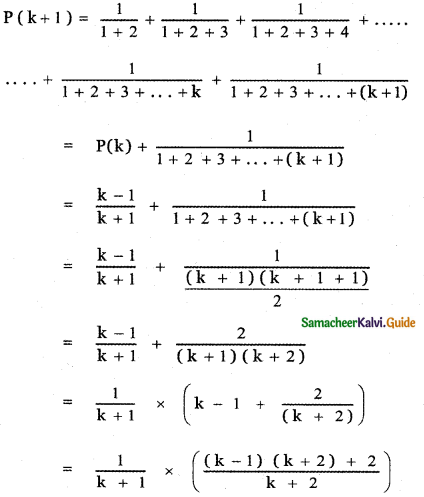
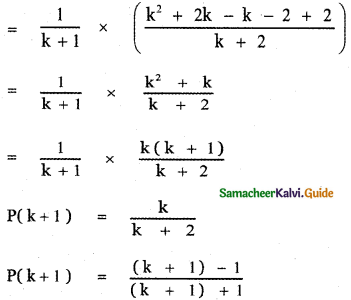
This implies p(k + 1) is true.
∴ Thus, we have proved the result for n = k + 1.
Hence by the principle of mathematical induction, the result is true for all natural numbers n ≥ 2.

is true for all natural numbers n ≥ 2
![]()
Question 7.
Using the mathematical induction, show that for any natural number n,

Answer:

Step 1:
First, let us verify the result for n = 1
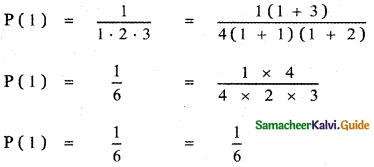
∴ The given result is true for n = 1
Step 2:
Let us assume the result for n = k

Step 3:
Let us prove the result for n = k + 1
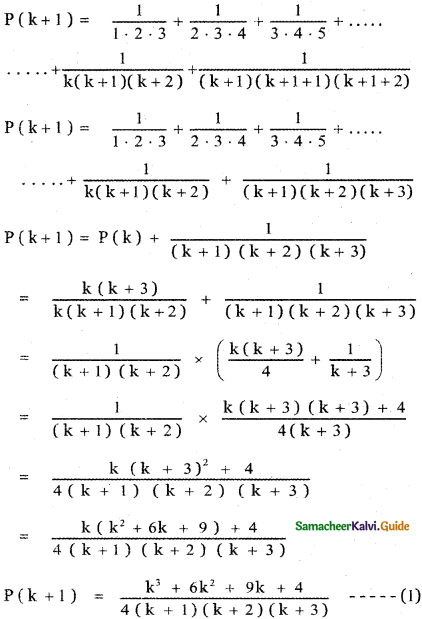
Factorizing k3 + 6k2 + 9k + 4
f (k) = k3 + 6k2 + 9k + 4
f(- 1) = (- 1)3 + 6(- 1)2 + 9(- 1) + 4
f(- 1) = – 1 + 6 – 9 + 4 = 0
∴ (k + 1) is a factor of f(k)
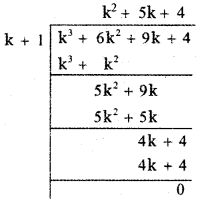
k3 + 6k2 + 9k + 4 = (k + 1) (k2 + 5k + 4).
= (k + 1) (k2 + 4k + k + 4)
= (k + 1) [k(k + 4) + 1(k + 4)]
= (k + 1) (k + 4) (k + 1)
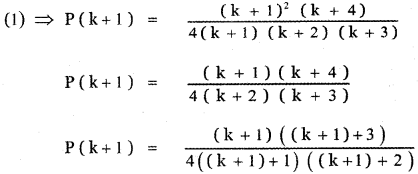
This implies P(k + 1) is true.
∴ Thus, we have proved the result for n = k + 1.
Hence by the principle of mathematical induction, the result is true for all natural numbers n.

is true for all natural numbers n
![]()
Question 8.
Using the Mathematical induction, show that for any natural number n,

Answer:

Step 1:
First, let us verify the result for n = 1
![]()
![]()
∴ The result is true for n = 1
Step 2:
Let us assume that the result is true for n = k

Step 3:
Let us prove the result for n = k + 1
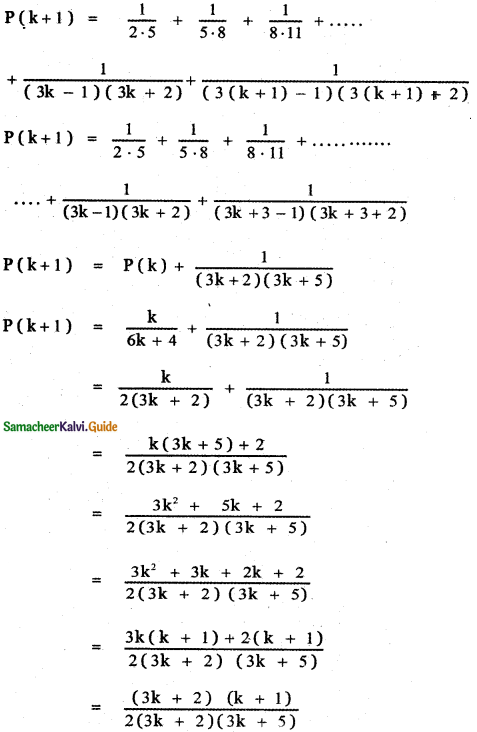
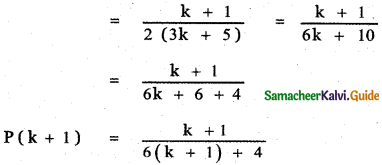
This implies P(k + 1) is true.
∴ Thus, we have proved the result for n = k + 1.
Hence by the principle of mathematical induction, the result is true for all natural numbers n.

![]()
Question 9.
Prove by mathematical induction that
1! + (2 × 2 !) + (3 × 3!) +…. .+ (n × n!) = (n + 1)! – 1
Answer:
P(n) is the statement
1! + (2 × 2!) + (3 × 3!) + ….. + (n × n!) = (n + 1)! – 1
To prove for n = 1
LHS = 1! = 1
RHS = (1 + 1)! – 1 = 2! – 1 = 2 – 1 = 1
LHS = RHS ⇒ P(1) is true
Assume that the given statement is true for n = k
(i.e.) 1! + (2 × 2!) + (3 × 3!) + … + (k × k!) = (k + 1)! – 1 is true
To prove P(k + 1) is true
p(k + 1) = p(k) + t(k + 1)
P(k + 1) = (k + 1)! – 1 + (k + 1) × (k + 1)!
= (k + 1)! + (k + 1) (k + 1)! – 1
= (k + 1)! [1 + k + 1] – 1
= (k + 1)! (k + 2) – 1
= (k + 2)! – 1
= (k + 1 + 1)! – 1
∴ P(k + 1) is true
⇒ P(k) is true, So by the principle of mathematical induction P(n) is true.
![]()
Question 10.
Using the Mathematical induction, show that for any natural number n, x2n – y2n is divisible by x + y.
Answer:
Let P(n) = x2n – y2n is divisible by (x + y)
For n = 1
P(1) = x2 × 1 – y2 × 1 is divisible by (x + y)
⇒ (x + y) (x – y) is divisible by (x + y)
∴ P(1) is true
Let P(n) be true for n = k
∴ P(k) = x2k – y2k is divisible by (x + y)
⇒ x2k – y2k = λ(x + y) …… (i)
For n = k + 1
⇒ P(k + 1) = x2(k + 1) – y2(k + 1) is divisible by (x + y)
Now x2(k + 2) – y2(k + 2)
= x2k + 2 – x2ky2 + x2ky2 – y2k + 2
= x2k.x2 – x2ky2 + x2ky2 – y2ky2
= x2k (x2 – y2) + y2λ (x + y) [Using (i)]
⇒ x2k + 2 – y2k + 2 is divisible by (x + y)
∴ P(k + 1) is true.
Thus P(k) is true ⇒ P(k + 1) is true.
Hence by the principle of mathematical induction, P(n) is true for all n ∈ N
![]()
Question 11.
By the principle of mathematical induction, prove that, for n ≥ 1, 12 + 22 + 32 + ………….. + n2 > \(\frac{n^{3}}{3}\)
Answer:
Let P (n) = 12 + 22 + 32 + ………….. + n2 > \(\frac{n^{3}}{3}\)
Step 1:
Let us first verify the result for n = 1
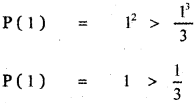
∴ The result is true for n = 1
Step 2:
Let us assume that the result is true for n = k.
P(k) = 12 + 22 + 32 + …………… + k2 > \(\frac{\mathrm{k}^{3}}{3}\)
Step 3:
Let us prove the result for n = k + 1
P(k + 1) = 12 + 22 + 32 + …………… + k2 + (k + 1)2
P(k + 1) = P(k) + ( k + 1)2
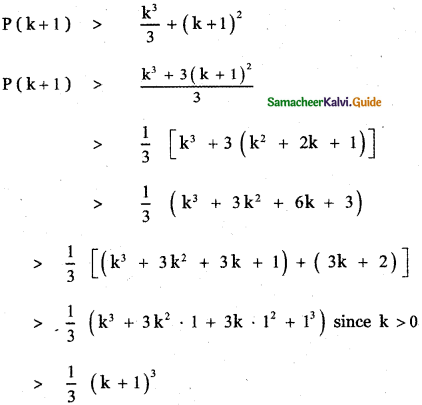
This implies P (k + 1) is true.
∴ Thus, we have proved the result for n = k + 1.
Hence by the principle of mathematical induction, the result is true for all natural numbers n.
12 + 22 + 32 + ………….. + n2 > \(\frac{n^{3}}{3}\)
![]()
Question 12.
Use induction to prove that n3 – 7n + 3, is divisible by 3, for all natural numbers n.
Answer:
Let P(n) : n3 – 7n + 3
Step 1:
P(1) = (1)3 – 7(1) + 3
= 1 – 7 + 3 = -3 which is divisible by 3
So, it is true for P(1).
Step 2:
P(k) : k3 – 7k + 3 = 3λ. Let it be true
⇒ k3 = 3λ + 7k – 3
Step 3:
P(k + 1) = (k + 1)3 – 7(k + 1) + 3
= k3 + 1 + 3k2 + 3k – 7k – 7 + 3
= k3 + 3k2 – 4k – 3
= (3λ + 7k – 3) + 3k2 – 4k – 3 (from Step 2)
= 3k2 + 3k + 3λ – 6
= 3(k2 + k + λ – 2) which is divisible by 3.
So it is true for P(k + 1).
Hence, P(k + 1) is true whenever it is true for P(k).
![]()
Question 13.
Use induction to prove that 5n + 1 + 4 × 6n when divided by 20 leaves a remainder 9 , for all natural numbers n.
Answer:
To prove 5n + 1 + 4 × 6n when divided by 20 leaves a remainder 9
That is to prove 5n + 1 + 4 × 6n – 9 is divisible by 20
Let P (n) be the statement 5n + 1 + 4 × 6n
which is divisible by 20
P (n) = 5n + 1 + 4 × 6n – 9 = 20λ
Step 1 :
Let us verify the statement for n = 1
P (1) = 5i + 1 + 4 × 61 – 9
= 52 + 4 × 6 – 9
= 25 + 24 – 9
= 49 – 9 = 40
which is divisible by 20
∴ The statement is true for n = 1
Step 2:
Let us assume that the statement is true for n = k
P(k) = 5k + 1 + 4 × 6k – 9 is divisible by 20
P(k) = 5k + 1 + 4 × 6k – 9 = 20λ …………… (1)
Step 3:
Let us prove the result for n = k + 1
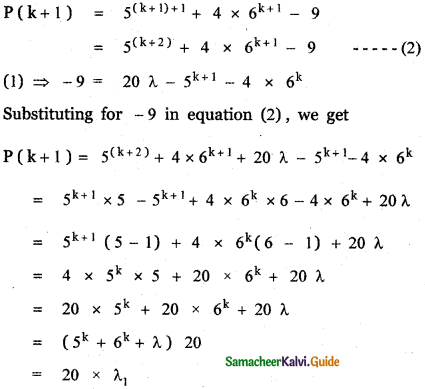
Hence, P(k + 1) is divisible by 20.
This implies P (k + 1) is true.
∴ Thus, we have proved the result for n = k + 1.
Hence by the principle of mathematical induction, the result is true for all natural numbers n.
Thus, 5n + 1 + 4 × 6n when divided by 20 leaves a remainder 9, for all natural numbers n.
![]()
Question 14.
Use induction to prove that 10n + 3 × 4n + 2 + 5 is divisible by 9, for all natural numbers n.
Answer:
Let P( n) = 10n + 3 × 4n + 2 + 5 is divisible by 9
Step 1:
Let us verify the result for n = 1
P ( 1 ) = 101 + 3 × 41 + 2 + 5
= 15 + 3 × 43
= 15 + 3 × 64
= 15 + 192 = 207
which is divisible by 9
Thus we have verified the result for n = 1
Step 2:
Let us assume the result is true for n = k
P(k) = 10k + 3 × 4k + 2 + 5 is divisible by 9
∴ 10k + 3 × 4k + 2 + 5 = 9m for some m
10k = 9m – 5 – 3 × 4k + 2 for some m
Step 3:
Let us prove the result for n = k + 1
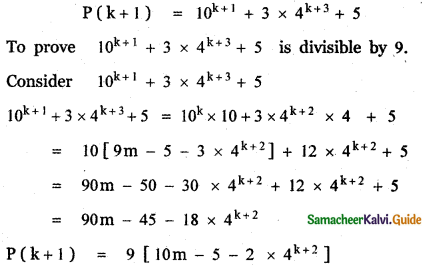
which is divisible by 9
This implies P (k + 1) is true.
∴ Thus, we have proved the result for n = k + 1.
Hence by the principle of mathematical induction, the result is true for all natural numbers n.
10n + 3 × 4n + 2 + 5 is divisible by 9,
for all natural numbers n.
![]()
Question 15.
Prove that using mathematical induction

Answer:
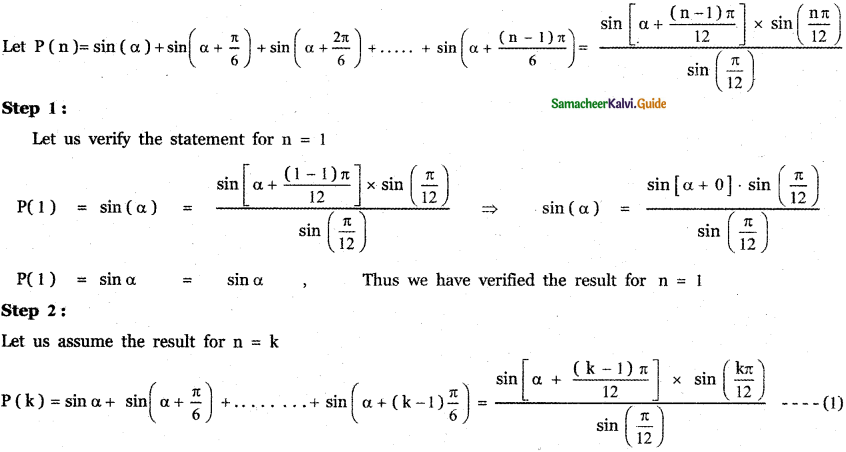
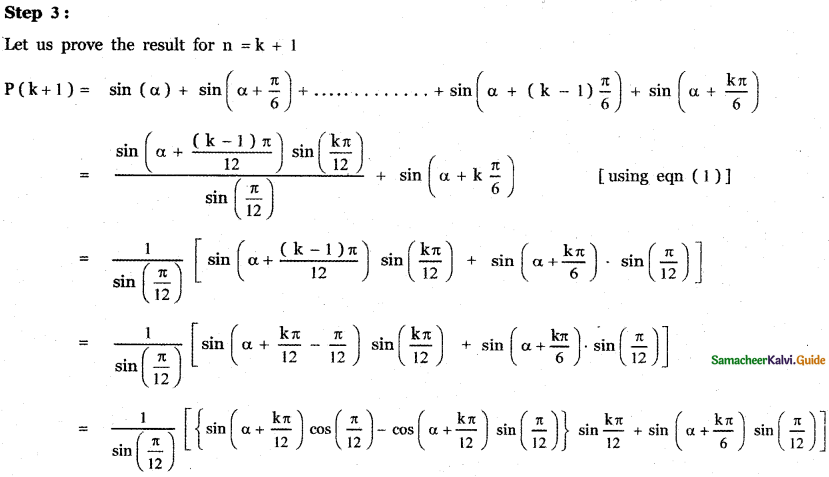
![]()
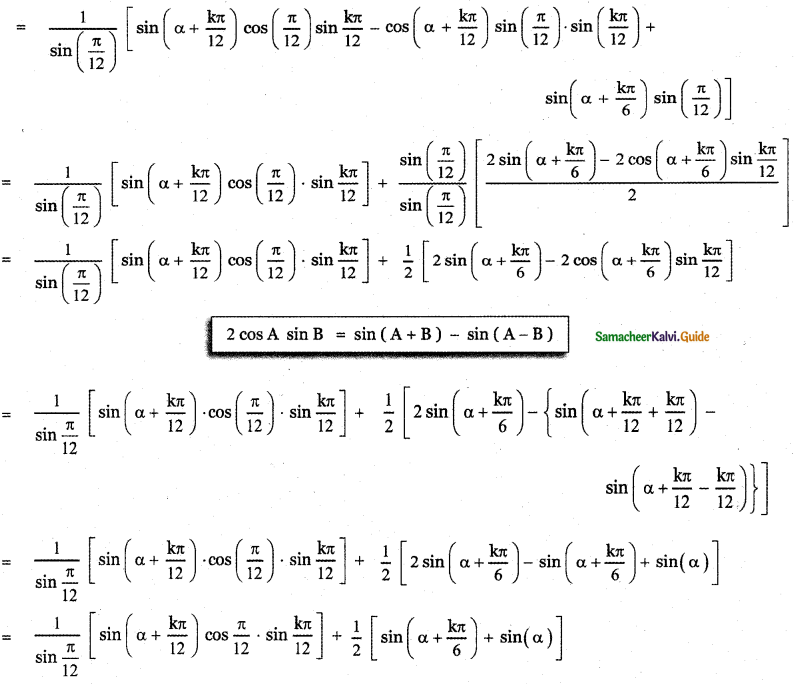
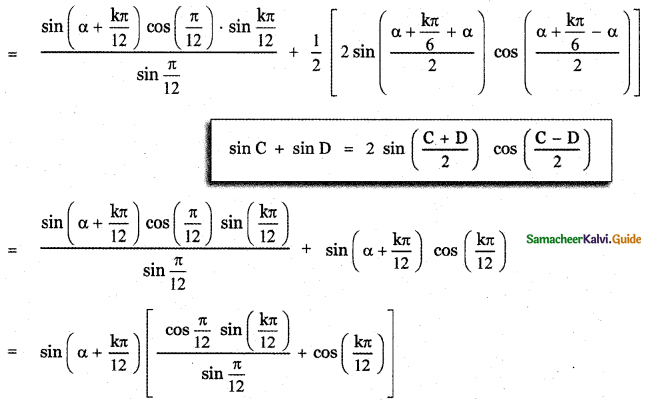
![]()
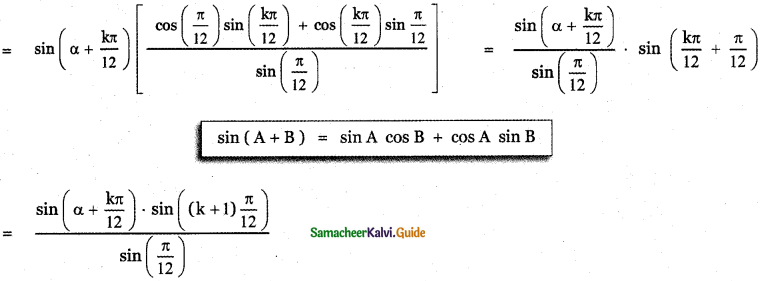
This implies P (k + 1) is true. Thus, we have proved the result for n = k + 1.
Hence by the principle of mathematical induction, the result is true for all natural numbers n.